| Article ID | Journal | Published Year | Pages | File Type |
|---|---|---|---|---|
| 2008435 | Peptides | 2008 | 12 Pages |
The dorsal vessel of the Vietnamese stick insect, Baculum extradentatum, consists of a tubular heart and an aorta that extends anteriorly into the head. Alary muscles, associated with the heart, are anchored to the body wall with attachments to the dorsal diaphragm. Alary muscle contraction draws haemolymph into the heart through incurrent ostia. Excurrent ostia lie on the dorsal vessel in the last thoracic and in each of the first two abdominal segments. Muscle fibers are associated with these excurrent ostia. Crustacean cardioactive peptide (CCAP)- and proctolin-like immunoreactivity is present in axons of the segmental nerves that project to the dorsal vessel, and in processes extending over the heart and alary muscles. Proctolin-like immunoreactive processes are also localized to the valves of the incurrent ostia and to the excurrent ostia. Neither the link nerve neurons, nor the lateral cardiac neurons, stain positively for these peptides. Physiological assays reveal dose-dependent increases in heart beat frequency in response to CCAP and proctolin. Isolating the dorsal vessel from the ventral nerve cord led to a change in the pattern of heart contractions, from a tonic, stable heart beat, to one which was phasic. The tonic nature was restored by the application of CCAP.
